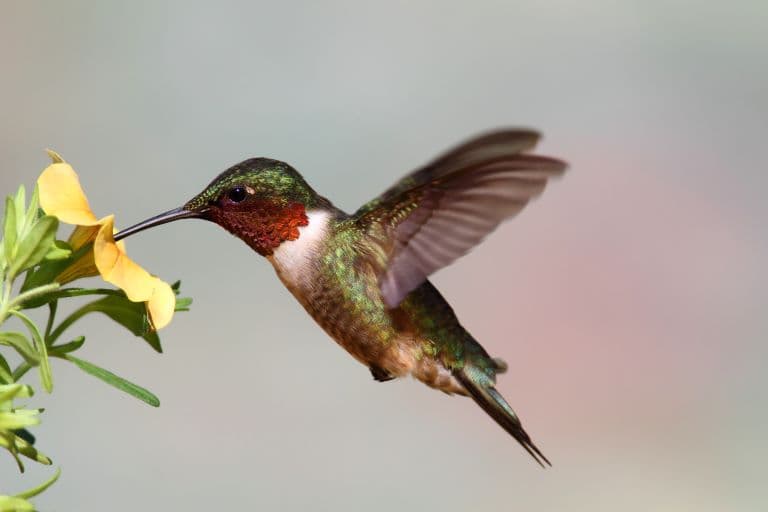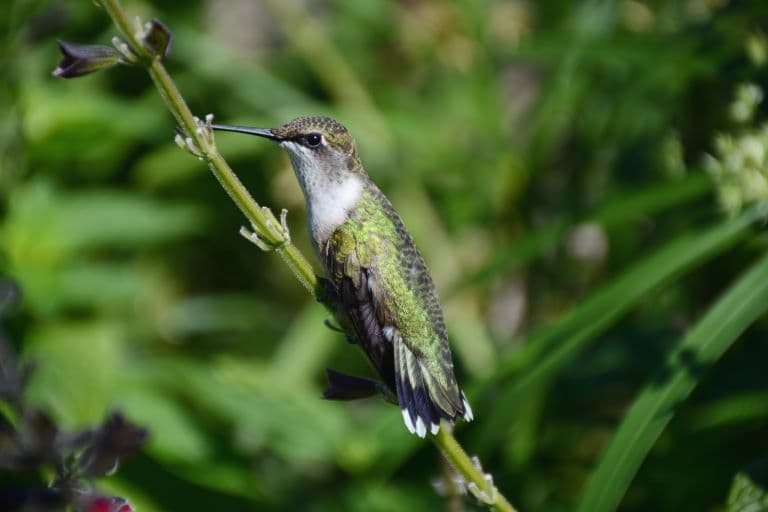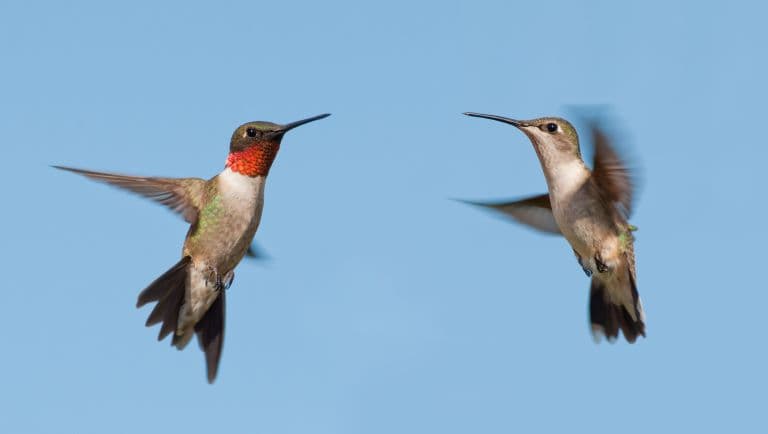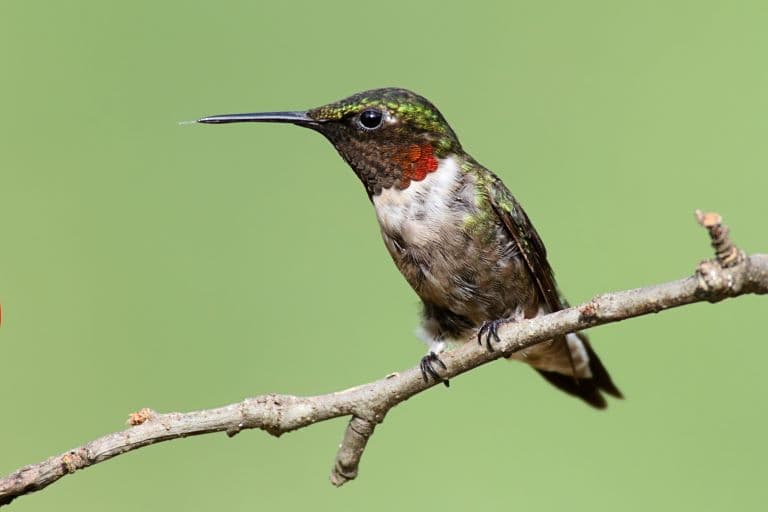Ruby-Throated Hummingbird Profile
Hummingbirds are typically South and Central American species – tropical residents, darting the short journeys between flowers saving every valuable drop of energy for their very existence.
But there are a handful of species that venture farther North. The US has fifteen species of hummingbird, and one even makes it as far North as Eastern Canada (and back again).
The ruby-throated hummingbird is one of the Northernmost hummingbird species, and is well deserving of a mention!

Ruby-Throated Hummingbird Facts Overview
| Habitat: | Fields, parks, clearings – anywhere with lots of flowers |
| Location: | Central America, Mexico, Eastern US, Canada |
| Lifespan: | Up to 7 years |
| Size: | 9cm (3.5 inches) long |
| Weight: | 3.4g (0.12 oz) |
| Colour: | Metallic green above and grayish white below, black wings |
| Diet: | Nectar, some arthropods |
| Predators: | Other birds, snakes, great big spiders |
| Top Speed: | Unknown |
| No. of Species: | 1 |
| Conservation Status: | Least Concern (IUCN) |
The Ruby-throated hummingbirds are tough little birds. They’re long-distance fliers, aggressively territorial and are thriving in a time when most animals are struggling.
And they’re doing all of this with the usual challenges of a hummingbird: no knees, lots of energy-intensive hovering and being small enough to be eaten by almost anything.
Interesting Ruby-Throated Hummingbird Facts
1. They’re North American hummingbirds
This little bird is a native to the US and one of fifteen hummingbird species to be found there. In fact, this is the most common and populous hummingbird species in the US and can be found breeding all over the eastern half of the country.
But they don’t stop there; this species breeds all the way up into the Canadian Rockies, and all the way eastward to Newfoundland. Of the 365 hummingbird species known, this is one of the most Northerly species, perhaps surpassed by Anna’s Hummingbird, which is said to have made it all the way to Alaska, but she wasn’t around to confirm or deny this. 1 2
2. They don’t have any knees
Hummingbirds aren’t really built for anything other than humming, which is something they do as a by-product of their rapid wingbeats. They can’t walk, on account of having no knees. Their legs are short and their feet are too big, so they mostly just sit there when they’re not flying.
Their feet are barely visible during this time, which is why their Latin order name, Apodiformes, means “footless”.
They are good at perching, which they can do in various ways, but the hummingbird’s real strength is in its flight.

3. But they can really fly
Unlike most birds, the humerus in this animal is specifically adapted to hover. It’s short, with a lot of leverage from the enormous pecs and delts – something which heavy lifters always prefer – and these powerful pushing muscles keep its tiny body in place while its little face gets to work sucking up nectar.
But more than this, and more than many, many hummingbird species could ever imagine, this tiny animal is migratory. Ruby-throated hummingbirds overwintering in Mexico, Panama or the Caribbean make the 1500km journey to the Eastern US, and other populations take on similar seasonal journeys too.
This takes toughness, and this little bird has it in droves.

4. They can be aggressive
As solitary animals, they have to protect what’s theirs. And they’re not very friendly about it, either. Like any accomplished lover, courtship and copulation combined can be over in a good couple of minutes, but outside of this, they don’t really care to be in the company of others.
After that, both males and females get back to aggressively defending their space, their food and their flowers by shouting at any passers-by to make sure they’re not welcome. This does explain why they’re so common in Florida. 3
5. They breathe a lot
Like many Floridians, these birds produce a lot of hot air. They have one of the highest metabolic rates of any animal, with a positively tachycardic heart rate of up to 1260 BPM. This likely peaks when they see a juvenile crossing their lawn, but doesn’t drop significantly beneath this, even at rest.
A healthy bird can take 250 breaths per minute at rest and during active flight can consume more oxygen per gram than the most powerful human athlete but ten times.
6. And shut down in the cold
A strategy like this is clearly vulnerable to resource scarcity, but the bird has another trick up its sleeve. While plants and flowers are plentiful, the hummingbird feeds all day. When temperatures drop and nectar flow is reduced, they go into hypothermic torpor or (essentially) hibernation.
This is important because during fasted periods the bird’s blood is so low in sugar that it would be considered a hypoglycaemic emergency in humans.
Likewise, they gain so much pre-migratory fat that they would be at risk of being shamed in the workplace by Lizzo.
As it takes off for its migration, the ruby-throated hummingbird is sitting at around 40% body fat. In the 20 hours it takes to get 900km along its journey this is already burned up.
This bird has one of the highest mass-specific metabolic rates known to science and while this might sound like a superpower for us rather doughy individuals, it is also incredibly hard to maintain. 4
7. They’re doing great
Despite this incredible challenge, one species seems to be on top of it.
Climate change, habitat destruction, air pollution, over-exploitation, domestic cats, the pet trade, Chinese medicine, Donald Trump and increased forest fires are all terrible products of modern society that are apparently no affect whatsoever on this little hummingbird.
They are thriving as the world burns, currently listed as of a 2020 assessment as being on the rise from an already impressive 36 million mature individuals. 5

Ruby-Throated Hummingbird Fact-File Summary
Scientific Classification
| Kingdom: | Animalia |
| Phylum: | Chordata |
| Class: | Aves |
| Order: | Apodiforms |
| Family: | Trochilidae |
| Genus: | Archilochus |
| species: | Colubris |
Fact Sources & References
- Gordon Ramel (2023), “Hummingbirds found in Canada”, Earth Life.
- Kathryn Stonich (2021), “Hummingbirds of the United States: A Photo List of All Species”, American Bird Conservacy.
- “Ruby-throated Hummingbird (Archilochus colubris)”, Texas Park and Wildlife.
- James L Hargrove (2005), “Adipose energy stores, physical work, and the metabolic syndrome: lessons from hummingbirds”, National Institute of Medicine.
- “Ruby-throated Hummingbird”, IUCN Red List.
